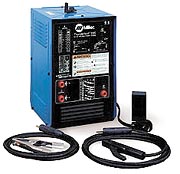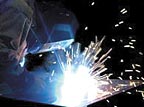
The hardfacing selection is more based on the application than strictly on composition. The use of more expensive materials where less expensive ones would have provided acceptable results should be avoided unless it is shown that a longer operating time and economic benefit can be achieved.
The shapes in which hardfacing materials are presented to welding depend on their properties established by composition. For the more ductile alloys, coiled wire usually is the preferred supply form. Less ductile materials, subject to cracking or bending, are supplied in straight rod lengths - cast or rolled. Totally brittle hardfacing materials are provided as powders or are packed in the hollow of roll-formed sheet foil tubes, possibly intermixed with special fluxes. Depending on application - manual or semiautomatic - rods or wires may be provided as covered electrodes. Some alloys are available in more than one form for different processes.
Surface preparation for hardfacing consists in cleaning the affected area and usually providing a machined or ground groove or channel into which the hardfacing alloy will be deposited and fused. Smooth and gradual transition is imperative to protect the edges, because hardfacing materials may tend to be chipped away under impact.
All welding processes have been used for hardfacing with overlay application. The selection of the proper welding process depends on many factors and has a major influence on the total operation cost. The shape, size and weight of the workpiece dictates if it can be moved to the production facility or if welding equipment must be made available at the work site. In the case of bulky, difficult to move augers, the process preferably would be manual, to be performed in place by a skilled welder using portable equipment. Mechanized setups sometimes can be implemented, when applicable, if long stretches of weld deposit are needed, using either Gas Metal Arc Welding (GMAW, also known as MIG) or Submerged Arc Welding (SAW), because of their higher deposition rate when compared to manual Shielded Metal Arc Welding (SMAW, or stick).
Conversely, small parts to be processed in large quantities usually will be more economically manufactured using semi-automatic or machine hardfacing in a properly established industrial environment.
The base metal will dictate the procedure to be used, including preheating for materials prone to cracking. Overlay materials may have thermal expansion characteristics very different from the base metal. In such cases, special procedures must be put in place, like possibly interposing a buffer layer of a third material with intermediate properties.
The process selected should provide the best deposition rate of the thinnest layer required for the hardfacing application, while limiting the dilution of the deposited hardfacing alloy layer into the base metal by controlling the heat input to a minimum. Slow cooling or stress relieving after surfacing may be required for mitigating the effects of residual stresses.

Oxyacetylene Flame
The equipment which uses the oxyacetylene flame is relatively simple and versatile and more economic than arc systems. The limitations are that a certain skill is required from the welder, and that the rate of deposition of hardfacing is rather slow when compared to other ones. Typical applications are for items where the surface to be overlaid is relatively small. The process can easily be applied in the field, even for replacement of broken sections of tools or implements.When the filler metal is in the form of wire or rod, the gas welding torch is that used for regular oxyacetylene welding. If the hardfacing material is supplied in powder form, then the torch includes a special dispenser to spread the powder ahead of the flame. The type of flame usually is neutral or slightly reducing (with excess acetylene), as recommended by the manufacturer of the particular filler employed.
If preheating is needed, it is done before hardfacing - either in a furnace or by manipulating the welding torch. The filler material, already preheated in the edge of the flame, is melted by introducing it in the hottest part of the flame when the base metal already is superficially in molten state.

Arc Welding
Hardfacing by arc welding is performed using all of the common processes and equipment. Of the arc welding group, SMAW, or stick welding, is the most common and versatile process, although it does not provide the highest deposition rate. The rate of dilution depends on materials and on the welder's skill.Submerged Arc Welding can provide a much higher deposition rate if the conditions are correct for uninterrupted alloy deposition of hardfacing filler wire. The limitations are that dilution tends to be higher unless speed is kept as high as possible, and that the process is not readily adapted to field conditions.
GMAW, or MIG, where shielding is provided only by inert gas, is readily applicable but only for those fillers supplied in wire form, and usefully complements the range of applications of the preceding process.
Gas Tungsten Arc Welding (GTAW), or TIG, is used either manually or in some mechanized form, but is used only for small parts, because dilution cannot be reduced below 10 percent, which sometimes is unacceptable.
Plasma Arc Welding (PAW) is used for hardfacing filler material in powder form, even of ceramic materials, which is fed through the arc and reaches very high temperatures. The filler, though, must be in the appropriate mesh size, must not conduct electricity (not to short the torch) and must not undergo vaporization or sublimation. Besides the elevated cost of equipment, the limitation is that it cannot be brought to the field.
ND
Report Abusive Comment